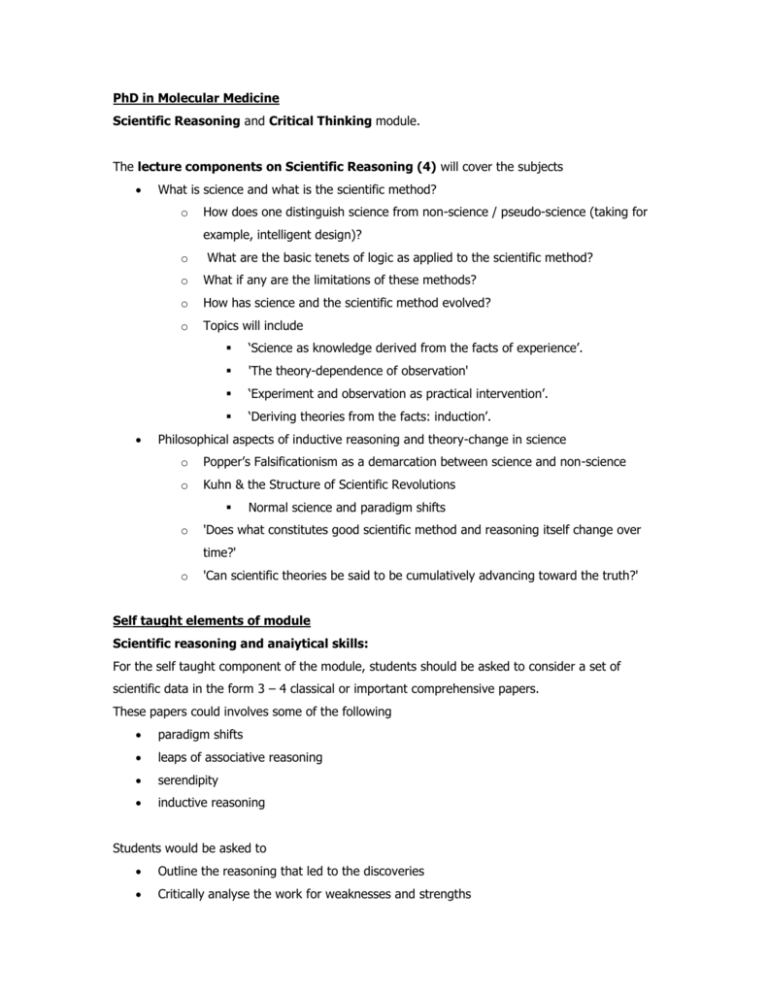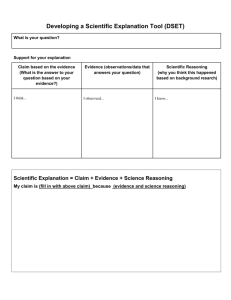Scientific-Reasoning-Critical-Thinking-Module
advertisement

PhD in Molecular Medicine Scientific Reasoning and Critical Thinking module. The lecture components on Scientific Reasoning (4) will cover the subjects What is science and what is the scientific method? o How does one distinguish science from non-science / pseudo-science (taking for example, intelligent design)? o What are the basic tenets of logic as applied to the scientific method? o What if any are the limitations of these methods? o How has science and the scientific method evolved? o Topics will include ‘Science as knowledge derived from the facts of experience’. 'The theory-dependence of observation' ‘Experiment and observation as practical intervention’. ‘Deriving theories from the facts: induction’. Philosophical aspects of inductive reasoning and theory-change in science o Popper’s Falsificationism as a demarcation between science and non-science o Kuhn & the Structure of Scientific Revolutions o Normal science and paradigm shifts 'Does what constitutes good scientific method and reasoning itself change over time?' o 'Can scientific theories be said to be cumulatively advancing toward the truth?' Self taught elements of module Scientific reasoning and anaiytical skills: For the self taught component of the module, students should be asked to consider a set of scientific data in the form 3 – 4 classical or important comprehensive papers. These papers could involves some of the following paradigm shifts leaps of associative reasoning serendipity inductive reasoning Students would be asked to Outline the reasoning that led to the discoveries Critically analyse the work for weaknesses and strengths Evaluate the relationship of the written report with the probable a priori reasoning Discuss analytical methods used in the studies Discuss the methodology and outcomes of these papers based on your understanding of the theory of scientific reasoning Hypothesis generation and inductive reasoning: The students will be provided with sets of scenarios and asked to develop proposals to develop these scenarios further. For example they may be provided with a set of observations, some of which will evidently be probabilistic in nature and asked to design experiments to evaluate these. This could be done in the form of a grant proposal. The students would work in two groups of three students. The groups are free to confer and exchange ideas. Students should be able to address the following issues: Design experiments which test hypotheses concerning proposed relationships. Determine possible alternatives and outcomes. Consider probabilities of occurrences. Predict logical consequences. Weight evidence, or proof. Overall Structure and Schedule Lectures on Scientific Reasoning Two sets of 2 hour lectures to be given on 12th &19th April (Wednesdays) 10:00 – 12:00 Tutorial dealing with grant proposal and write ups To be given by 1 – 2 PIs Organisation Class will be divided into two groups of 3 students. The groups will be different for each assignment. The students will be provided with self taught resource material at the outset. They will return their reports in 4 weeks. Each report will be not more than 8 - 12 pages and one of the reports will contain a review of a critical area covered in the lecture material (the longer report). Alternatively they may write an individual essay on some area of lectures. Assessment: The students will divide into 2 groups of three for each assessment Assignment 1) Part A) Answer question on lecture content (~1400 words) Part B) Develop a document which applies the knowledge derived from the lectures in assessing a set of papers describing important developments. Document length: ~1000 word document. 2) Develop a grant proposal given a basic scenario. This should be approximately 1500 words in length and not exceed 1800 words. It will include a description of 1. Abstract (300 word max) 2. What is the nature of the problem to be investigated 3. Why is this important 4. Background data leading up to the proposal 5. Aims of the project 6. Outline of experiments and methodology required to address the problem Example Scenario: A number of studies have indicated the potential for a secondary locus in the MHC demonstrating an association with Coeliac Disease. In particular this is associated with markers in the region of the TNF gene. A number of genes exist in this region. Develop an hypothesis to investigate this region further for a role in CD. Isuues to be consider: Linkage is to SNPs in the LTA-TNF region o Investigate haplotype structure of the region to identify how many genes may be implicated o Identify a particular gene that may have a putative role in disease o What are the functions of these genes? o What is known about them? o What is unknown about them? o Design experiments to investigate their roles in the context of the disease in question based on available resourses – you define. Genetic experiments – can you further refine the region? Cell biology experiments – can you establish likely function? Can you show an association in patients?








